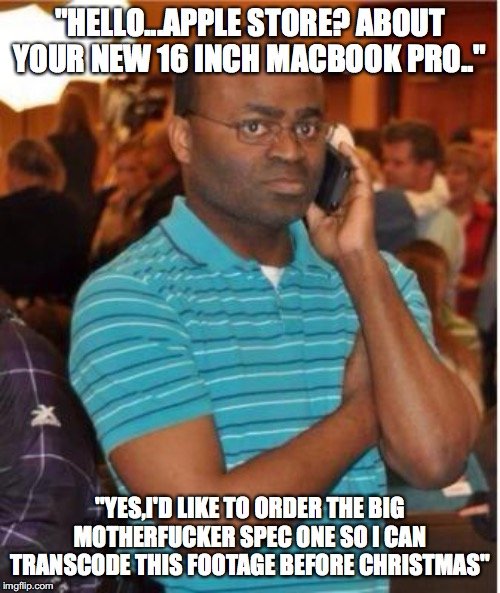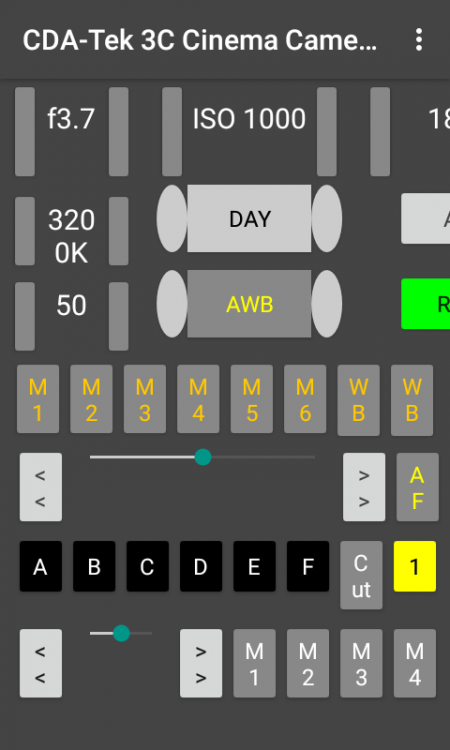-
Posts
6,076 -
Joined
-
Last visited
Content Type
Profiles
Forums
Articles
Everything posted by BTM_Pix
-
I'm da behind schedule man, certainly.
-
I haven't really been paying attention to the price in the meantime but at launch it was £2430 in the UK including VAT. Its now available pretty much everywhere at £2199 and I paid a bit less again after some negotiation. Its not super duper end of line price slashing levels of course but the 15% price fall in just over 3 months, not to mention the readily available stock, struck me as quite the significant contrast to the Pocket4K.
-
What am I smoking? Some very fine Montecristos bought with the savings I made on the one I bought.
-
Yeah, I was surprised it had dropped in price so quickly.
-
Blocked and reported
-
Six weeks since the last post on here about the Pocket6K, did you all sell them or something I picked one up today and it annoyingly had the same scratched mount and bits of shavings QC as @Andrew Reid had with his so it will be going back for a replacement. On the upside, if you are after a remote focusing solution for it (as it isn't compatible with anything for the 4K) then I now know a man who has a solutiom for you.
-
Yeah but after me bigging that route up, I've just been transcoding some footage on my cheap MacBook Air and...
-
I don't have any direct experience with Sony's higher end glass (or even that much with their lower end as I tend to use adapted) to say whether there are any killer app type ones. A lot of people rave about them but how they stack up directly against comparable EF lenses is open to debate. I'm about to become a reluctant short term owner of a Pocket 6K, so a set of lenses that I would think would be very worthwhile for that but which aren't available in EF would be Sigma's f1.4 trio of 16mm, 30mm and 56mm. Offset against that of course you have the 18-35mm f1.8 which perversely isn't available in E mount There is also the perennial aspect of EF mount cameras not being able to directly take PL lenses and, again on a personal note, Leica M lenses which add up to me personally viewing the EF as being a great mount for lenses due to its adaptability but actual EF cameras themselves less so. I think thats why the RF mount on the Komodo is a great option as it gives you that extra distance to accommodate PL with a couple of great options for using EF lenses either boosted or with the Variable ND whilst still maintaining a "factory" level of electronic compatibility.
-
It depends on how many electronic MFT lenses you have and love that you wouldn't want to give up and the sensor size of the camera. With a £15 adapter you can use MFT lenses on an E mount, which obviously you can't do the other way round. Whilst these are useless for electronic lenses they are perfectly fine for manual ones both native (so the Meike cine primes and Voigtlanders etc can do double duty) and also any adapted lenses. With regard to coverage, a lot of the MFT lenses can get out to about 89 or even 95% of an APS-C sensor but the image quality invariably tails off at the edges so in practical terms its less whereas with the E mounts you'll have no issue. The E mount gives you room to grow as well as you can buy EF full frame lenses, use them with a speedbooster if your current camera is APS-C but then be able to step up to a full frame camera without changing lenses. I have an A7Rii and A6500 and get a lot of mileage out of that flexibility. Where native MFT scores is for compact electronic lenses but only if you are sticking with the smaller format sensor and unless you have an LS300 (or someone else pulls the same trick) then you can't go any bigger with them. Again though, having said that, with the E mount you can use the TechArt PRO and have autofocus control of very compact, fast Leica M primes (and by extension virtually all other types of manual lens) so its not something that can't be done. For me personally, I don't have any native MFT mount lenses that I'm fond enough of that I wouldn't swap all my MFT mount cameras irrespective of sensor size (I have them ranging from Super16 in BMPCC to standard in GX80 to Super35 in LS300) to be E mount in a heartbeat if it were possible.
-
In the case of FD lenses, the "New" designation is to differentiate between the second generation versions of lenses which have a bayonet mounting mechanism rather than a sneaky trick https://cameraville.co/blog/list-every-canon-fd-lens-ever-made
-
Most of my experience of them is in physical shops there where you could probably take the goods straight into an operating theatre without fear of challenge! I've only had a couple of things from there off eBay and they were mint condition as well and also looked like they had been wrapped by this Rowan Atkinson character Yeah, they look like they'd have no bother being matched up. There is definitely some value for money in the FD stuff.
-
With the Japanese ones though the condition they sell them in is probably cleaner than when it left the factory ! Is the f2 maybe a compromise option or do they not match that well with your 50mm ? https://www.ebay.co.uk/itm/Excellent-Canon-New-FD-NFD-24mm-f-2-Wide-Angle-MF-Lens-From-Japan-292/133235260635?hash=item1f0570bcdb:g:NDgAAOSwLARdv9kl
-
Sadly, my hands are far from full while doing that.
-
In terms of feelings, the second one of these two makes me feel like you either included it by mistake or you need to sort out that focus peaking ?
-
The first port of call for me with wides like that would be the edges, for both sharpness and curvature so a brick wall is usually the simplest way to do that. Anything upright vertical on either edge of the frame will suffice though so if you are shooting indoors a couple of pencils etc could be used. Its a very obvious basic test but with ultra wides it might save a lot of time in additional testing as its likely going to be the most important determining factor as to whether you find the lens acceptable. The subtleties of all the other parameters may be rendered moot if the overall image is distorted enough to act as a quasi fisheye. If it passes that test then you can move on to picking out the bits you need from this guide. https://www.lensrentals.com/blog/2010/11/how-to-test-a-lens/
-
Quite surprising how bad it is comparatively at 40mm. Did you shoot that from the roof of Mount Pleasant car park ? Last time I tried to shoot something off there, I was asked to vacate the premises in no uncertain terms !
-
I reckon you might want to re-think that thread title. People with a certain type of mind might be expecting it to contain an entirely different type of product and be very disappointed. Like I was.
-
Did you get your file formats back with those commands that I posted last night ?
-
You just need to send it a format that it understands and it will restore the correct menus. So when you are connected to the camera type any one of these into a browser : http://192.168.54.1/cam.cgi?mode=setsetting&type=videoquality&value=avchd_50p_28mbps http://192.168.54.1/cam.cgi?mode=setsetting&type=videoquality&value=avchd_50i_17mbps http://192.168.54.1/cam.cgi?mode=setsetting&type=videoquality&value=mp4_25p_100mbps_4k If you aren't in a PAL region then use these ones instead : http://192.168.54.1/cam.cgi?mode=setsetting&type=videoquality&value=avchd_60p_28mbps http://192.168.54.1/cam.cgi?mode=setsetting&type=videoquality&value=avchd_60i_17mbps http://192.168.54.1/cam.cgi?mode=setsetting&type=videoquality&value=mp4_30p_100mbps_4k
-
Right, leave it with me as it is close enough on both for me to see the issue and fix it. Use it in landscape for now and I'll get a fix organised and rolled out.
-
OK, I have a very small screen device here to run some tests on. Would you say that this was in the ballpark of what you are seeing in portrait mode ?
-
Thanks for that. Just a very quick test if you can which will help a bit, on the startup screen select Key1 as this is the portrait locking mode designed for the Blackberry but may help here if you are using it in portrait mode. If you start it up when that is enabled and see if you get the same issue. It won't orient to landscape when its in this mode but it will at least give me a starting point to look at other things. Cheers
-
Sorry to hear you've had problems. The Android version shouldn't be an issue as it should be compatible with 2.1 onwards. If you can answer a couple of questions then I'll be able to try and get to the bottom of it. What type of phone is it, specifically screen size ? Are you using it in Portrait or Landscape ? Which parts of the UI aren't scaling and can you post a screenshot ? Have you moved from v1.4 to v1.5 or from a previous version? Which combination of focus and zoom do you have enabled in the UI (if any) ? Are you using it with the Nucleus Nano? Does it become unresponsive when controlling a specific function from the app (i.e. changing aperture) or when it is receiving something from the camera (i.e. you've changed the aperture on the camera) ? Are you using an EF adapter when this happens and if so which one/lens ? Are you running anything else on BLE on the phone (headset etc) ? Cheers







